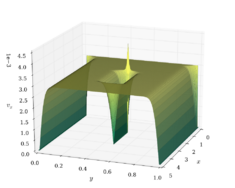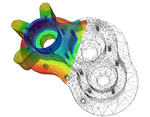Integro-differential equation
 From HandWiki - Reading time: 5 min
From HandWiki - Reading time: 5 min
| Differential equations |
|---|
 |
| Classification |
| Solution |
In mathematics, an integro-differential equation is an equation that involves both integrals and derivatives of a function.
General first order linear equations
The general first-order, linear (only with respect to the term involving derivative) integro-differential equation is of the form
As is typical with differential equations, obtaining a closed-form solution can often be difficult. In the relatively few cases where a solution can be found, it is often by some kind of integral transform, where the problem is first transformed into an algebraic setting. In such situations, the solution of the problem may be derived by applying the inverse transform to the solution of this algebraic equation.
Example
Consider the following second-order problem,
where
is the Heaviside step function. The Laplace transform is defined by,
Upon taking term-by-term Laplace transforms, and utilising the rules for derivatives and integrals, the integro-differential equation is converted into the following algebraic equation,
Thus,
Inverting the Laplace transform using contour integral methods then gives
Alternatively, one can complete the square and use a table of Laplace transforms ("exponentially decaying sine wave") or recall from memory to proceed:
Applications
Integro-differential equations model many situations from science and engineering, such as in circuit analysis. By Kirchhoff's second law, the net voltage drop across a closed loop equals the voltage impressed
The activity of interacting inhibitory and excitatory neurons can be described by a system of integro-differential equations, see for example the Wilson-Cowan model.
The Whitham equation is used to model nonlinear dispersive waves in fluid dynamics.[2]
Epidemiology
Integro-differential equations have found applications in epidemiology, the mathematical modeling of epidemics, particularly when the models contain age-structure[3] or describe spatial epidemics.[4] The Kermack-McKendrick theory of infectious disease transmission is one particular example where age-structure in the population is incorporated into the modeling framework.
See also
References
- ↑ Zill, Dennis G., and Warren S. Wright. “Section 7.4: Operational Properties II.” Differential Equations with Boundary-Value Problems, 8th ed., Brooks/Cole Cengage Learning, 2013, p. 305. ISBN:978-1-111-82706-9. Chapter 7 concerns the Laplace transform.
- ↑ Whitham, G.B. (1974). Linear and Nonlinear Waves. New York: Wiley. ISBN 0-471-94090-9.
- ↑ Brauer, Fred; van den Driessche, Pauline; Wu, Jianhong, eds (2008). Mathematical Epidemiology. Lecture Notes in Mathematics. 1945. pp. 205–227. doi:10.1007/978-3-540-78911-6. ISBN 978-3-540-78910-9.
- ↑ Medlock, Jan (March 16, 2005). "Integro-differential-Equation Models for Infectious Disease". http://people.oregonstate.edu/~medlockj/other/IDE.pdf.
Further reading
- Vangipuram Lakshmikantham, M. Rama Mohana Rao, “Theory of Integro-Differential Equations”, CRC Press, 1995
External links
- Interactive Mathematics
- Numerical solution of the example using Chebfun
 |
26 views | Status: cached on August 06 2024 20:15:49
↧ Download this article as ZWI file
 KSF
KSF
